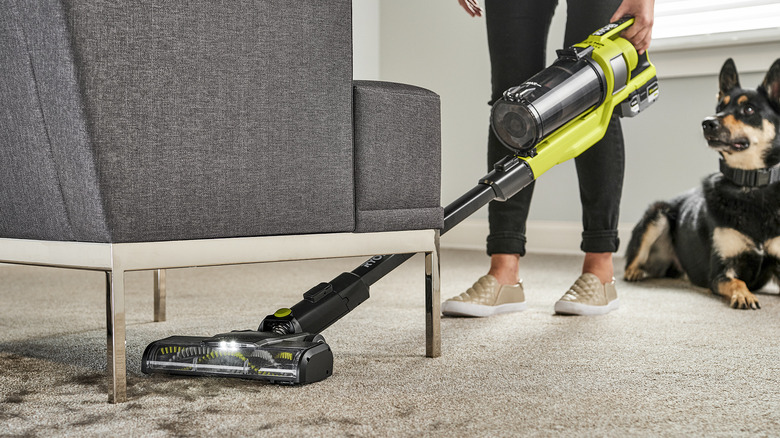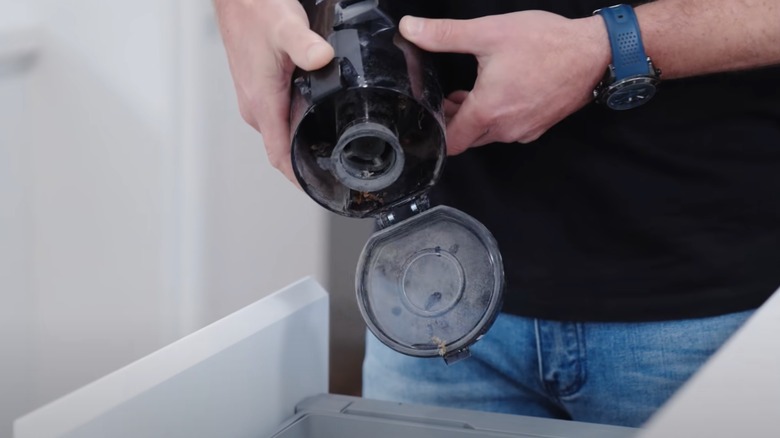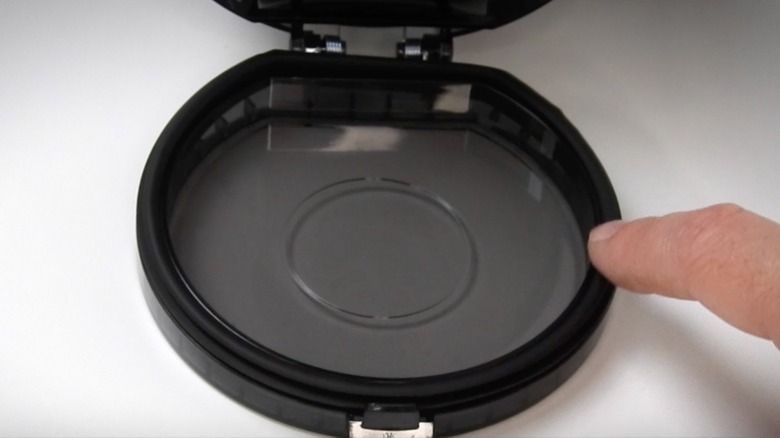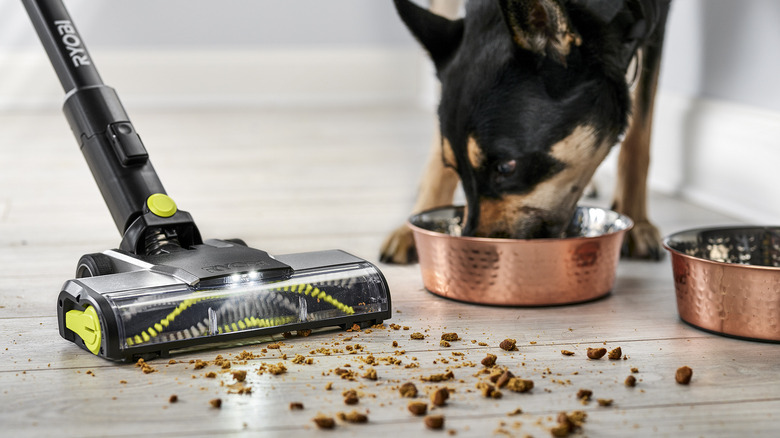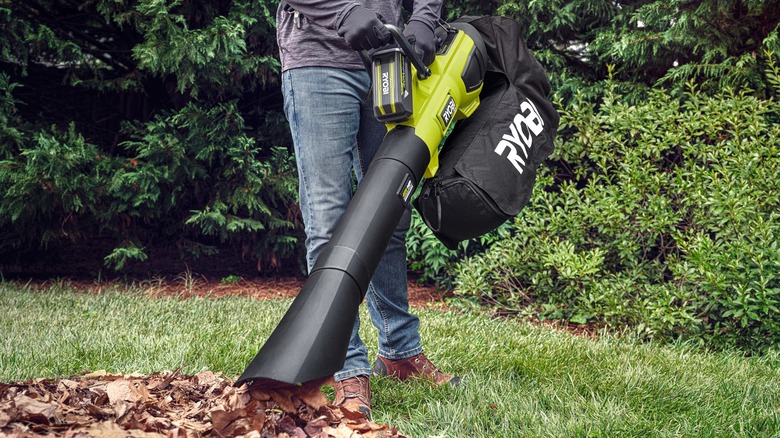Why Your Ryobi Vacuum Has Lost Suction (And Fixes To Try)
Over the last several decades, Japanese tool manufacturer Ryobi has become one of the most trusted names in the game. In recent years the company's ONE+ lineup of hand-held and battery-powered devices have become staples in many American households, despite only being available for purchase through their online storefront or through the company's exclusive brick-and-mortar retailer The Home Depot.
While the ONE+ brand boasts no shortage of power tools and yard equipment like drills, saws, and augers, Ryobi also makes a full line of handheld and standup vacuum cleaners built to rival competitors in terms of power, battery life, and user-friendly design. If you've already added a Ryobi vacuum to your stable of home cleaning devices, you likely know them to be more than capable of helping keep your floors, rugs, and carpets free of even the toughest-to-clean debris. Nonetheless, it is entirely possible that you have, on occasion, fired up your Ryobi vacuum and set about cleaning your floors only to find it lacking in suction.
While an irreparable malfunction could be the cause of the issue, that may not ultimately be the case, as there are several non-terminal reasons your Ryobi might have lost suction, including dirty filters, clogged tubes, and loose seals, among others. So, before you consider buying a new vacuum, here's a few tricks to try to get your Ryobi back to its usual dirt-devouring self.
Try cleaning the debris collector and filter
No matter what model of Ryobi vacuum cleaner you have in your home, the device's primary function is to help users remove dirt, hair, and dust from the various surfaces that regularly need cleaning. But the fact that a vacuum is primarily meant to serve as a cleaning tool doesn't mean it won't occasionally need to be cleaned itself, and yes, failing to routinely tend to the cleanliness of your Ryobi can lead to an eventual loss of suction.
That's particularly true if you've allowed the device's collection canister or bag to become completely full of dirt and debris. After all, once the collection container is full, there's literally no place for additional dirt to go, and if there's no place to store such refuse, your vacuum may not even be able to remove if from your floors. If you think that's the case with your Ryobi vacuum, you may be able to correct the problem by simply emptying out the collection container in the nearest trash can. As most Ryobi devices are equipped with easy-to-empty receptacles, this should be a breeze whether you've got a standup device or one of Ryobi's handheld vacuums.
Just FYI — you can likely further restore your Ryobi's suction power by cleaning the device's filter, which should be easily accessible once you've removed the dust collection bin. If you're unsure how and where to access the filter on your device, consult the vacuum's owner's manual.
Examine the dust canister's rubber seal
If you're still having suction issues with your Ryobi vacuum even after you've emptied the dust bin and given the device's filter a cleaning, you might need to take a look at other potential culprits in the general area. That list includes the little piece of rubber that seals the cover of the dust bin when you open and close its flap for emptying.
That tiny piece of rubber can cause big problems for your Ryobi vacuum should it become loose or dislodged from the canister, and those problems indeed include a decline in the device's suction. As you might expect, the dislodging of that important rubber seal can happen whenever you open and close the canister, so you'll want to be extra careful when emptying it to ensure the seal stays in place. However, should the seal get dislodged, you should easily be able to maneuver it back into place.
You will first need to know where exactly the seal is, with the circular piece of rubber securing around the inside of the flap that opens when you empty dirt. If you find it's become dislodged, you should be able to press it firmly back in place with your fingers, ensuring that the springs connecting the lid to the dust bin are visible and in no way obstructed by the seal. It should go without saying that if your seal is damaged and no longer performing its function, it may simply need to be replaced.
Clogged brushes head and tubes may be behind the problem
If you're still experiencing issues with your device after undertaking those measures, the problem may be in either the vacuum's roller brush head or the tube connecting it to the vacuum itself. It may seem absurdly obvious, but if either of those components are jammed up with dirt and debris it will most certainly affect the vacuum's suction capabilities.
We'll start with the brush head as it's the first point of contact with all the dirt, debris, and hair you so tirelessly work to remove from the floors of your home. Yes, hair can be a particularly problematic part of that equation as it can easily get wrapped around the brushes to the point of decreasing, or even stopping its spinning function. Should that happen, your device will not be able to pick up as much debris as it probably should. With most modern vacuums (Ryobi products included) it's easy to extract a roller bar or brush head, inspect it for issues and any hair that might be jamming it up.
As for the connecting tube, you can check for clogs by disconnecting it from both the vacuum and head, then simply looking through it. If you see an obstruction, try to remove it. Before you reconnect it, be sure to examine the elbow turn where the tube runs into the vacuum and debris is ferried into the dust bin because it's also susceptible to the sort of build up that dampens a vacuum's functionality.
For outdoor blower vacs, check that the proper settings have been selected
While Ryobi's indoor vacuums are the primary focus of this article, we'd be remiss if we didn't touch on potential suction issues for the company's outdoor blower/vacuum combos, which are susceptible to various issues that can affect suction capability. As it is, you can perform many of the same checks and tricks listed above if you should run into suction issues with a Ryobi blower/vacuum. Given that such devices are typically used to suction up leaves and other heavy debris from yards and driveways, it's not uncommon for them to get clogged.
However, once you've eliminated a clog as the culprit for your suction problems, Ryobi recommends that owners take a look at the switch or lever used to change the tool's function from suction to blower, as the device will not perform either function when it becomes stuck in a position between the two. Such an issue may seem unlikely, but it's apparently a common enough problem that Ryobi has a support page dedicated to it, so make of that what you will.
Anyway, per support, one potential reason the switcher might get jammed is the buildup of dirt and grime, which is not uncommon for outdoor tools. You can likely prevent such an issue by regularly cleaning your device, paying close attention to the area around the switch. If it's already stuck, you may be able to fix the problem by scrubbing the area clean and moving it from one function to the other.
